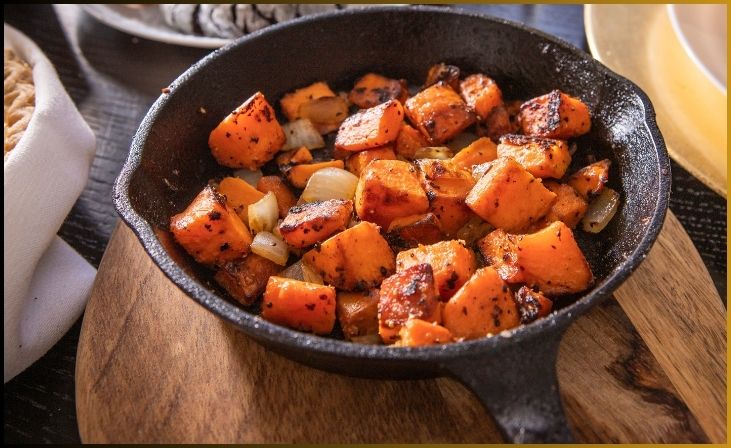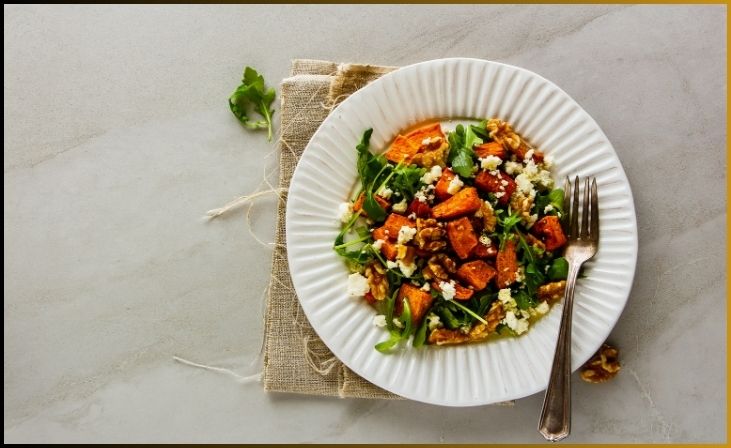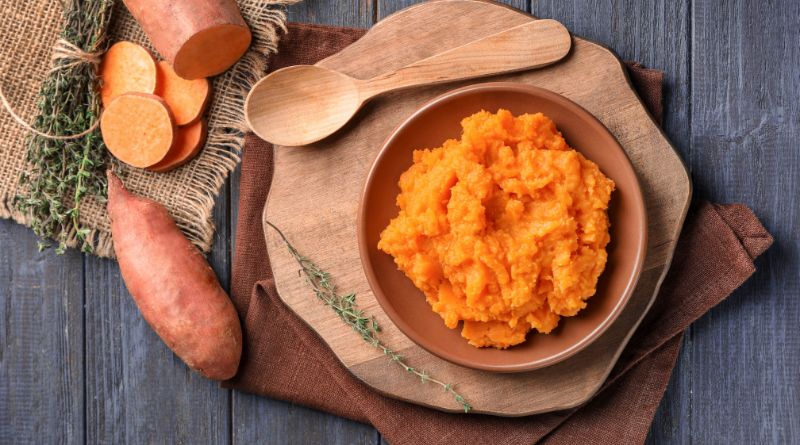Sweet potatoes are a versatile and delicious addition to any meal, offering a unique blend of sweetness and earthy flavors. Whether you prefer roasted, mashed, or baked, mastering the art of cooking sweet potatoes can elevate your culinary skills. In this guide, we’ll explore various techniques and tips to help you prepare perfect sweet potatoes every time.
From their vibrant orange hue to their numerous health benefits, sweet potatoes are a kitchen favorite for many. They are not only a fantastic source of vitamins and fiber but also a great canvas for creativity in the kitchen. Whether you’re a seasoned chef or a beginner, this post will equip you with the knowledge you need to cook sweet potatoes to perfection.
How to Choose the Right Sweet Potato?
Baking sweet potatoes is truly an art, and selecting the right sweet potato is the first step. Your sweet potato’s shape matters more than you might think. Here are some key considerations when choosing the perfect sweet potato:
Opt for Length: Sweet potatoes come in various shapes and sizes, from short and stubby to long and slender. When you’re planning to stuff a baked sweet potato, it’s crucial to pick a long one. This elongated shape allows you to evenly load your ingredients, creating a visually appealing and fully loaded treat. While shorter sweet potatoes have their place in dishes like curries and mashes, the longer ones tend to be sweeter and have a more substantial texture when used for loading or making pulp-based recipes.
Avoid Rot: Keep an eye out for any signs of rot on the sweet potato. Occasionally, certain areas may become dry and start to deteriorate. These parts can still be used in dishes like curries or soups, but they are not suitable for baked sweet potato recipes. It’s important to remove the affected portions before cooking.
Seek Symmetry: Select a sweet potato with symmetrical proportions. Asymmetrical sweet potato will bake evenly and offer consistent flavor throughout. To check for symmetry, mentally draw an imaginary line from the top to the bottom, right down the middle of the sweet potato. Ensure that there is a nearly equal amount of potato on both sides of this line. This balance will result in a more satisfying and delicious baked sweet potato.
What Does “Perfectly Cooked Sweet Potato” Mean?
Regardless of the cooking method chosen, there are specific qualities to consider when assessing a well-cooked sweet potato. These factors include desired flavors and textures, as well as potential dealbreakers, though it’s important to acknowledge that some of these parameters are subjective. Nevertheless, thinking in these terms can be quite helpful as we explore sweet potato preparation.
Sweetness: A well-cooked sweet potato should inherently possess a degree of sweetness, as the name suggests. Sweetness in sweet potatoes is a result of an enzymatic process involving amylase, which converts the tuber’s complex starches into maltose, a basic sugar molecule. Extended cooking promotes this enzymatic action, and the more starch that converts to maltose, the sweeter the sweet potato becomes. We’ll delve deeper into this concept shortly.
Aroma: The delightful nutty, earthy, and caramel aroma associated with cooked sweet potatoes is attributed to various volatile compounds. Studies have revealed that there are approximately 60 volatile compounds in cooked Jewel sweet potatoes, with three being the most prominent: phenylacetaldehyde (imparting a perfume-like scent), maltol (adding caramel notes), and methyl geranate (evoking a sweet candy fragrance). While we may not be concerned with each specific compound, what truly matters is that our cooked sweet potatoes are highly aromatic, far from plain or bland. As we’ll discover, the cooking method we choose can significantly impact this aromatic quality.
Texture: The texture of cooked sweet potatoes can vary significantly depending on the variety, ranging from fluffy and crumbly to moist and soft. Given this variability, it’s challenging to make blanket statements about desired textures. It might be more practical to identify what we aim to avoid in cooked sweet potatoes, including gumminess, dry, leathery spots, crunchiness, or uncooked sections. In most cases, leaning toward a softer texture, regardless of the variety, is a safe approach to ensure a satisfying sweet potato experience.
Quick Link: 7 Best Olive Oils for Cooking: A Flavorful Guide
Techniques of Cooking Sweet Potatoes

There isn’t a single definitive method to employ this technique, but there are various adjustments you can make depending on your available time and preferences. If you have sweet potatoes on hand and no immediate need to cook them, freezing them until they’re completely solid is an option. In a hurry? Even a shorter stint in the freezer to partially freeze the flesh can help the sweet potatoes spend more time at the ideal lower temperature during roasting, even if it’s not as perfect.
Moreover, you can get creative with this approach. While a roasted sweet potato on its own or with a bit of butter is delicious, there are endless possibilities. For example, try topping the frozen-roasted sweet potatoes with whipped crème fraîche and granola, as demonstrated in this recipe.
Here are some other variations to explore:
Start It Cold, Even in the Oven
If you’re pressed for time, you can preheat your oven while the sweet potatoes are in the freezer. Then, you can place the semi-frozen sweet potatoes in the hot oven for a quicker result. However, if you can spare an extra hour or so, consider starting the frozen sweet potatoes in a cold oven, as demonstrated by Kenji. This gradual heating allows more time for enzymes to work, resulting in sweeter and more aromatic sweet potatoes.
Start Low, Then Crank the Temp
Expanding on the idea of starting in a cold oven, you can manipulate the oven temperature further. Begin with an initial lower temperature, around 300°F, followed by a finishing roast at 450°F. The lower initial roasting temperature prolongs the enzymatic sweetening phase, while the final high heat phase eliminates excess moisture and produces charred, smoky, caramel-like flavors.
Wrap It Up, Then Take It Off
Wrapping sweet potatoes in foil offers several advantages. It prevents the outer layer from drying out and overheating too quickly, allowing enzymatic activity to continue. This results in a more even texture. Additionally, you can introduce aromatic elements within the foil package to enhance the flavor.
While wrapping in foil is excellent for the initial cooking and flavor development, this method aims to achieve the charred, caramel-like flavor by unwrapping the sweet potatoes and letting them continue baking, allowing maltose to undergo further Maillard reactions and caramelization.
Best Tips for Cooking Sweet Potatoes
Try these effective tips for cooking sweet potatoes at home.
Preheat Your Oven
Before embarking on your sweet potato culinary adventure, the first and crucial step is to preheat your oven. The recommended temperature is 400°F (200°C). Preheating is not a mere formality; it plays a pivotal role in ensuring your sweet potatoes are cooked to perfection.
By preheating, you allow the oven to reach the desired cooking temperature, creating a stable and consistent environment for your sweet potatoes. This uniform heat distribution is essential for even cooking, ensuring that every bite of your sweet potatoes is just as delectable as the last. It’s a fundamental step that shouldn’t be overlooked, as it sets the stage for a delicious and well-prepared dish. So, give your oven the time it needs to reach that optimal temperature, and you’ll be well on your way to sweet potato success.
Wash and Dry
The first step in preparing sweet potatoes is to give them a thorough wash under cold running water. Using a scrubbing brush, gently but effectively remove any dirt or debris from the potato’s skin. This cleansing process is essential to ensure that your sweet potatoes are clean and free from any unwanted particles.
Once they are clean, the sweet potatoes should be dried meticulously with a clean towel. This step not only promotes hygiene but also plays a significant role in enhancing the flavor and texture of the sweet potatoes. By ensuring they are dry, you pave the way for a more satisfying culinary experience, as excess moisture on the surface can impact the cooking process. So, take the time to wash and dry your sweet potatoes for a delectable end result.
Poke Holes
To avoid the unwelcome surprise of sweet potatoes bursting during the cooking process, take a simple yet effective precaution. Grab a fork and gently pierce the sweet potatoes with small holes all over their surface. These holes serve a crucial purpose by allowing steam to escape as the sweet potatoes cook.
This venting of steam ensures that the cooking is even and that the sweet potatoes remain intact throughout the process. Without these small punctures, the steam inside can build up, creating pressure within the sweet potatoes, which may cause them to burst open, potentially leading to uneven cooking and a less appealing presentation. So, by using a fork to create these tiny escape routes for steam, you’re not only preserving the integrity of the sweet potatoes but also ensuring a delicious and evenly cooked outcome.
Also Read: 10 Essential Spices Every Home Cook Needs, According to Chefs
Coat with Oil
Before you place your sweet potatoes in the oven, don’t forget a crucial step to elevate their texture and flavor. Begin by applying a light, even coating of oil to the sweet potatoes. You have options such as olive oil or coconut oil, both of which serve a dual purpose. Not only do these oils add essential moisture to the sweet potatoes, but they also contribute to enhancing their flavor.
This oil coating plays a pivotal role in achieving a mouthwatering outcome. It not only prevents the sweet potatoes from drying out during the baking process but also helps create a delectably crispy skin. As the sweet potatoes cook, the oil aids in achieving that perfect balance between a tender interior and a slightly crispy, flavorful exterior. So, be sure not to skip this step, as it’s the secret to your sweet potatoes becoming a delectable culinary delight.
Season with Salt and Pepper
Taking your sweet potatoes to the next level in terms of taste is a simple yet impactful process. After applying the oil coating, don’t forget to add a touch of seasoning. A gentle sprinkling of salt and a dash of pepper can work wonders. These seasonings not only enhance the overall flavor but also play a vital role in balancing the inherent sweetness of the potatoes.
Salt introduces a savory element, creating depth and complexity in taste, while pepper adds a subtle kick and an extra layer of flavor. Together, they elevate the sweet potatoes from delicious to truly delectable. The salt and pepper act as culinary harmonizers, ensuring a well-rounded taste experience. So, consider this easy but effective step as the finishing touch that transforms your sweet potatoes into a culinary masterpiece.
Place on Baking Sheet
Before you embark on the baking process, set the stage for easy and hassle-free cooking. Begin by lining a baking sheet with either parchment paper or aluminum foil. This simple step serves a dual purpose: it ensures your sweet potatoes don’t stick to the sheet during baking and simplifies the cleanup afterward.
Once your baking sheet is properly lined, arrange your prepared sweet potatoes on it, making sure they are evenly spaced and not in direct contact with each other. This spacing promotes even cooking and allows hot air to circulate around each sweet potato, resulting in consistent results. Moreover, it prevents the sweet potatoes from sticking together, ensuring that they maintain their individual integrity as they bake. This practical setup not only streamlines the cooking process but also makes cleanup a breeze, leaving you more time to savor your delicious creation.
Roast in the Oven
With your sweet potatoes prepared and the oven preheated, it’s time to embark on the roasting process. Place them in the preheated oven and let the magic unfold. Roasting sweet potatoes typically takes about 45-50 minutes to reach the desired level of tenderness, where they can be effortlessly pierced with a fork.
During this roasting time, the sweet potatoes undergo a delightful transformation. The heat coaxes out their natural sweetness and flavor, rendering them a truly delectable addition to your meal. The process intensifies their taste, creating a harmonious balance between tenderness and a slightly crispy exterior. As they roast, they develop a richness that complements various dishes, making sweet potatoes a versatile and cherished ingredient in your culinary repertoire. So, be patient and savor the rewarding results of roasting that bring out the best in these delightful tubers.
Let Them Rest
Once you’ve expertly roasted your sweet potatoes to perfection, the journey isn’t over just yet. To achieve the best possible flavor and texture, it’s essential to exercise patience and allow your sweet potatoes to rest for a few minutes after removing them from the oven.
During this resting period, the sweet potatoes cool slightly, creating an optimal temperature for consumption. This step is not merely about temperature; it’s also a crucial phase where the flavors within the sweet potatoes settle and intensify. The few minutes of rest allow the natural sweetness and aromatic notes to fully develop, resulting in a more satisfying and flavorful culinary experience.
So, resist the urge to dive right in and let your sweet potatoes rest for a brief moment. Your patience will be richly rewarded with sweet potatoes that are not only at the right temperature to enjoy but also at the peak of their taste potential.
Add Toppings
After achieving sweet potato perfection through roasting, the culinary canvas is yours to embellish. The next step is to explore your creativity by adding your preferred toppings. Options abound, such as velvety butter, indulgent maple syrup, a dusting of fragrant cinnamon, or a generous handful of chopped nuts.
These toppings serve as the finishing touch that elevates your sweet potatoes to a higher level of taste and enjoyment. They’re not just adornments; they play a vital role in complementing the natural sweetness of the potatoes and introducing extra layers of flavor. Butter imparts a rich creaminess, maple syrup drizzles on a luxurious sweetness, cinnamon brings a warm and aromatic dimension, and nuts contribute delightful texture and nutty notes.
With these customizable toppings, your sweet potatoes become a deliciously versatile dish, ready to satisfy your taste preferences and make every bite a delightful experience. So, embrace the opportunity to add your favorite flavors and make your sweet potatoes truly your own.
Use Leftovers
The versatility of sweet potatoes extends beyond the initial serving, as they excel as leftovers. Their adaptable nature means you can repurpose them into a multitude of delectable dishes. From transforming them into crispy sweet potato fries to incorporating them into a comforting sweet potato casserole or crafting a classic sweet potato pie, the options are nearly endless.
The beauty of sweet potatoes lies in their ability to seamlessly integrate into various culinary creations, each time offering a unique twist on flavor and texture. Their natural sweetness and creamy texture can elevate dishes ranging from savory to sweet, making them a versatile ingredient in your kitchen. So, don’t let any sweet potato remnants go to waste; instead, embrace the opportunity to turn them into another delightful masterpiece that will delight your taste buds all over again.
5 Reasons to Add Sweet Potatoes to Your Diet

Sweet potatoes, often praised for their delectable flavor, are not just a tasty addition to your meals but also a nutritional powerhouse. There are numerous compelling reasons to make sweet potatoes a regular part of your diet. Let’s explore the top 5 reasons why you should consider incorporating sweet potatoes into your meals.
Improved Digestive Health
The dietary fiber content in sweet potatoes is a game-changer for your digestive health. It aids in digestion, prevents constipation, and promotes gut health. By including sweet potatoes in your diet, you can enjoy a smoother and more efficient digestive system while maintaining a balanced gut microbiome.
Digestive issues can be a source of discomfort, affecting your overall well-being. Sweet potatoes act as a natural remedy. The high fiber content ensures that food moves through your digestive tract smoothly, reducing the risk of constipation. Moreover, the fiber also provides nourishment to the beneficial bacteria in your gut, supporting a balanced and healthy microbiome.
Enhanced Immune Function
Sweet potatoes are a fantastic source of vitamin C, a well-known immunity booster. Vitamin C not only enhances your immune system but also plays a crucial role in wound healing and the prevention of infections. By regularly consuming sweet potatoes, you can give your immune system the support it needs to keep you healthy.
A robust immune system is your body’s defense against illnesses. Vitamin C, abundant in sweet potatoes, helps your immune cells function optimally. It aids in the production of white blood cells and antibodies, making your body better equipped to fight off infections. This essential nutrient is your ally in staying healthy year-round.
You May Also Like: 10 Tasty Ways to Enjoy Avocados
Eye Health
Beta-carotene, a precursor to vitamin A, is abundant in sweet potatoes. This essential nutrient is a true friend to your eyes. It protects your vision, helps prevent night blindness, and contributes to overall improvements in eyesight. Including sweet potatoes in your diet can be a natural way to care for your eye health.
Our eyes are invaluable, and preserving their health should be a top priority. Beta-carotene is a powerful antioxidant that shields your eyes from oxidative stress. It also plays a pivotal role in the production of rhodopsin, a pigment essential for night vision. By adding sweet potatoes to your meals, you are taking a proactive step in maintaining clear and sharp vision.
Blood Sugar Regulation
Despite their natural sweetness, sweet potatoes have a unique ability to release sugar slowly into the bloodstream. This gradual sugar release helps regulate blood sugar levels, making sweet potatoes a valuable addition to the diet of individuals with diabetes.
Controlling blood sugar levels is crucial for those with diabetes, and sweet potatoes can be an essential part of a well-balanced diet. The complex carbohydrates in sweet potatoes are digested slowly, preventing rapid spikes in blood sugar. This stable release of sugar keeps your energy levels steady and reduces the risk of insulin resistance, making sweet potatoes a smart choice for diabetes management.
Anti-Inflammatory Properties
Sweet potatoes contain a group of compounds known as anthocyanins, which are prized for their anti-inflammatory properties. These compounds play a vital role in reducing inflammation, which is associated with serious health conditions such as heart disease, diabetes, and various malignancies. By including sweet potatoes in your diet, you can help your body combat these inflammatory issues.
Bottom Line
In conclusion, cooking sweet potatoes is a delightful addition to your culinary repertoire, offering a range of flavors and preparation methods. By following the techniques and tips outlined in this guide, you can create mouthwatering sweet potato dishes that will impress your family and friends. So, don’t hesitate to explore the possibilities of cooking sweet potatoes and enjoy the delicious rewards.
FAQs
When selecting sweet potatoes, look for firm, unblemished ones with smooth skin. Avoid any that are soft or have visible signs of decay.
Peeling sweet potatoes is optional. It depends on your recipe and personal preference. Many recipes allow you to cook them with the skin on for added flavor and nutrients.
Store sweet potatoes in a cool, dark place, away from direct sunlight. They can last for several weeks when stored properly.
Yes, you can freeze cooked sweet potatoes. Simply allow them to cool, then place them in an airtight container or freezer bag. They can be stored in the freezer for up to six months.







